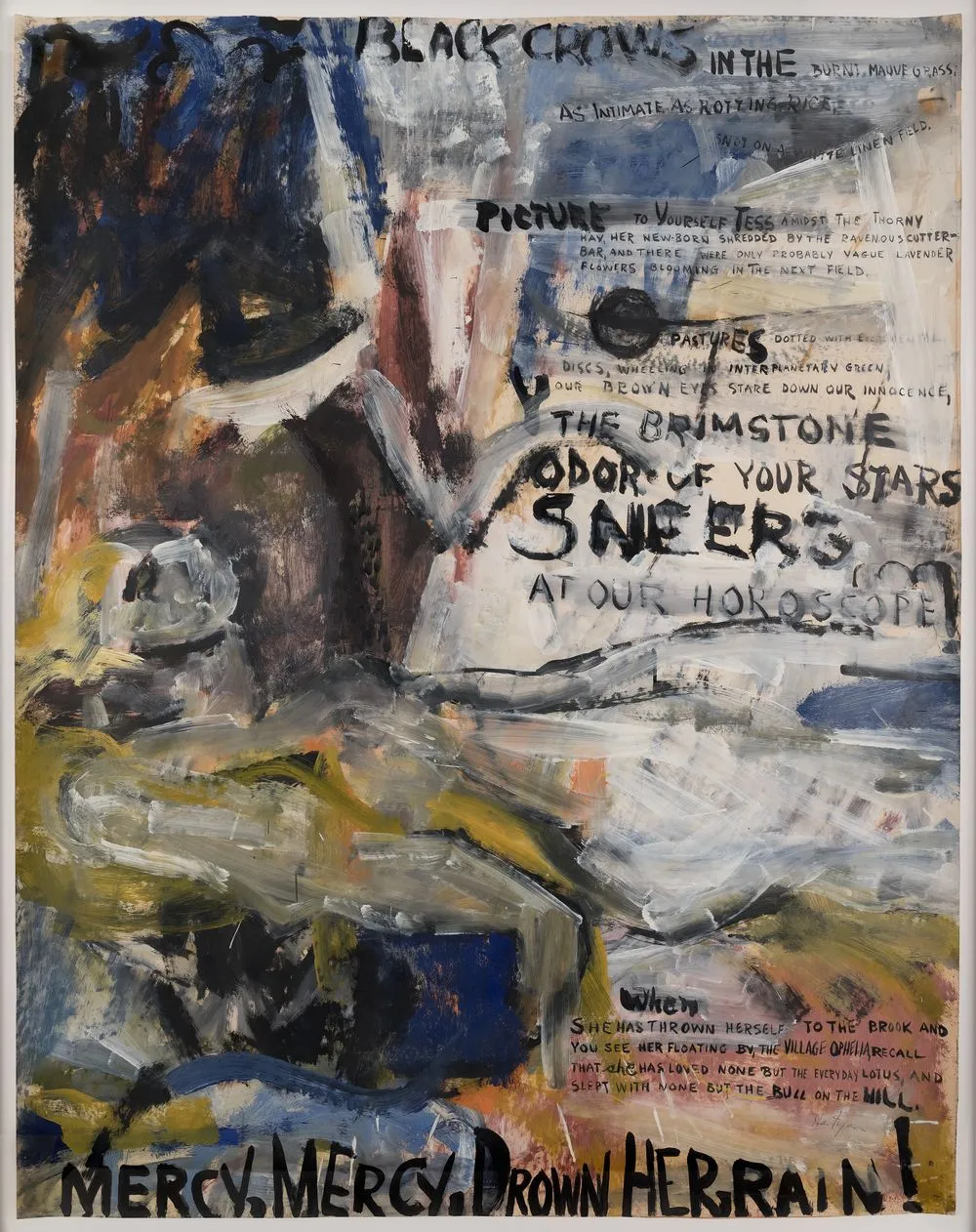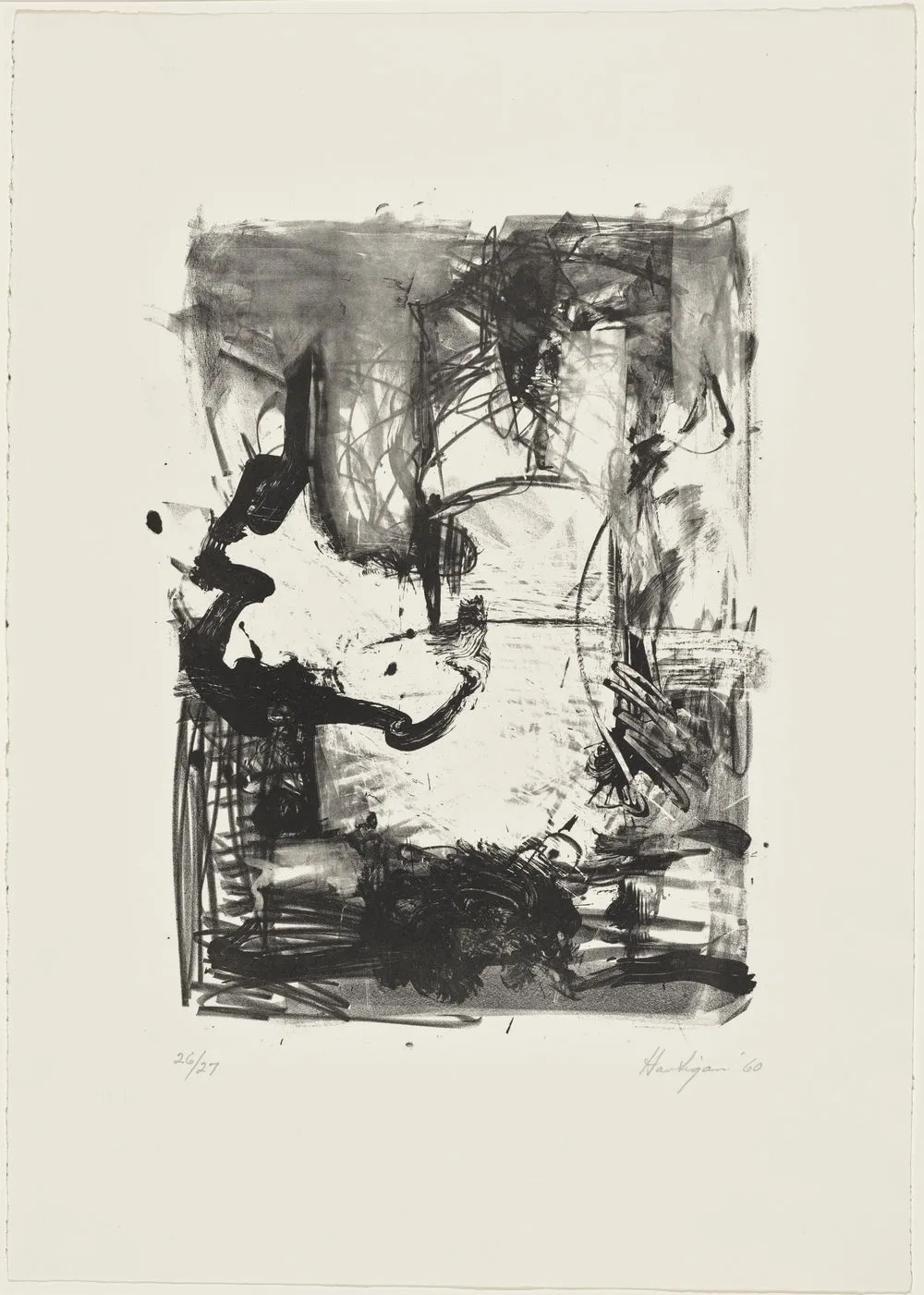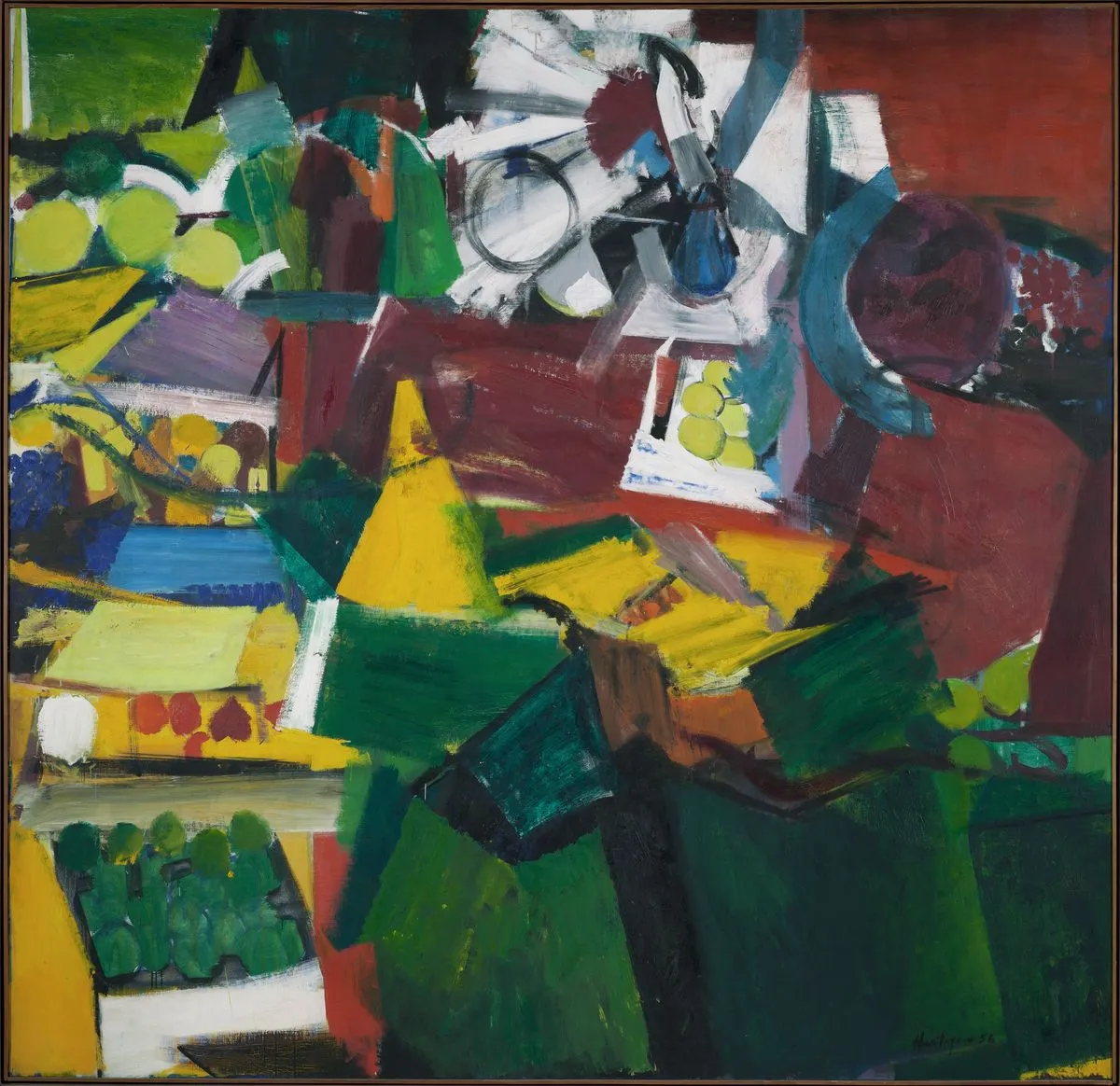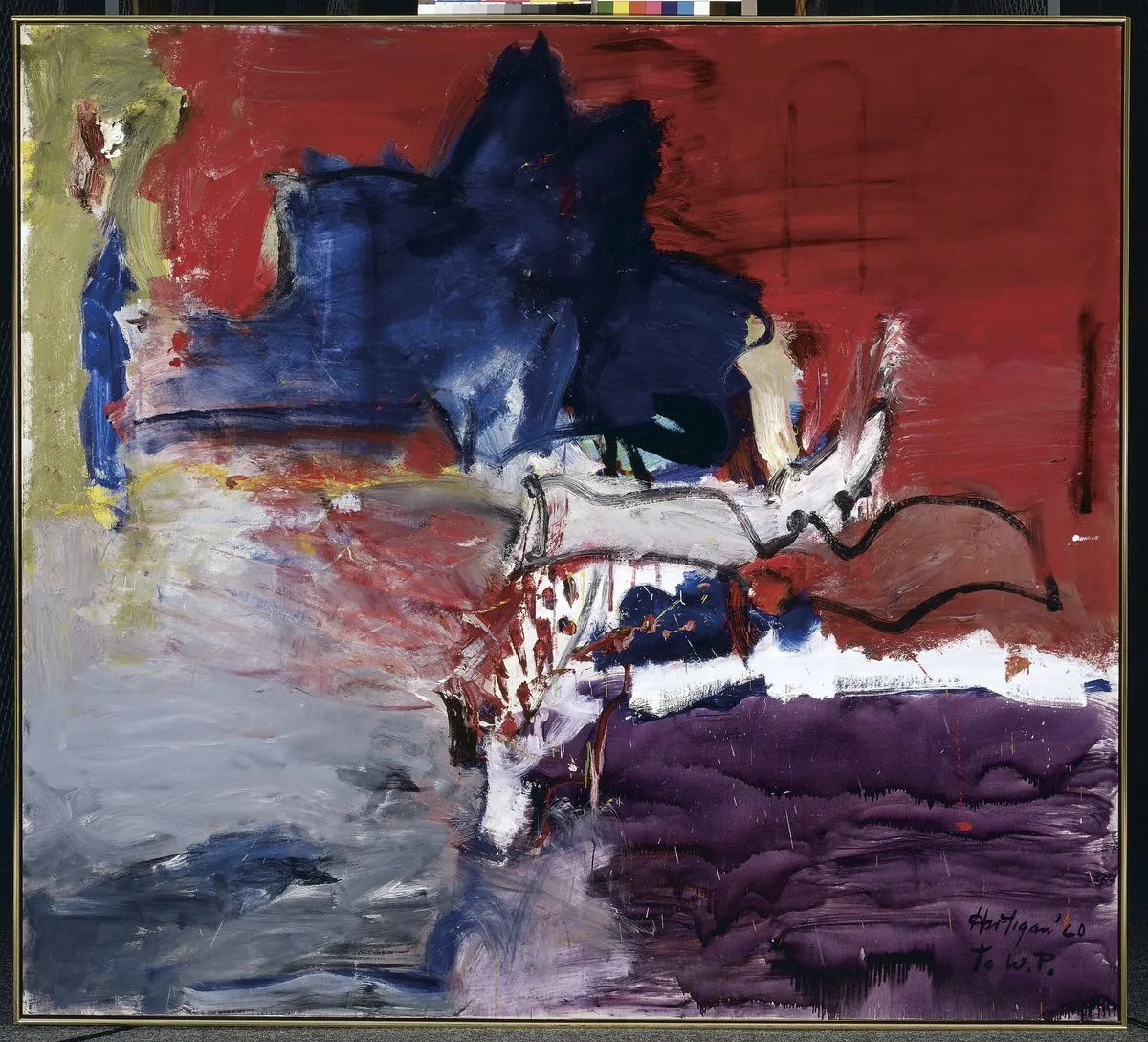 Grace Hartigan, Barbara Guest Archaics, 1968. Ink and collage on paper, 24 × 30 in., Rex R. Stevens and the Grace Hartigan Estate; Photo: Courtesy of the Estate of Grace Hartigan/ACA Galleries, New York
Grace Hartigan, Barbara Guest Archaics, 1968. Ink and collage on paper, 24 × 30 in., Rex R. Stevens and the Grace Hartigan Estate; Photo: Courtesy of the Estate of Grace Hartigan/ACA Galleries, New York Creative expression is often a solitary venture. Some visual artists, authors, songwriters, etc. do their best work when they can isolate themselves from outside influences and fully engage with their inner drives. But it doesn't have to be that way. Grace Hartigan (1922-2008) was an accomplished painter who not only didn't need to be alone to function as an artist; she led a fertile social existence that had everything to do with her creative efforts. Hartigan, who came into her own as an abstract expressionist in the 1950s and later turned to a direction that saw her produce canvases that were a melding of pure abstraction and figuration, came to be friends and artistic collaborators with poets like Frank O'Hara and Barbara Guest, and these associations informed her artistic directions.
Hartigan, who also worked in lithography, collage-making, and portraiture, was a brave spirit who made a habit of breaking norms. In her early career, she challenged the prevailing male dominance within the sphere of abstract expressionist art. Later, she was among those who took a stand against the established thinking that fine art and literature shouldn't and couldn't be intertwined. And, throughout her adult life, she sought out and embraced friendships with queer people, although she was straight, and did so during an era when such activities tested the boundaries of societal standards.


Hartigan's collaborations with O'Hara and Guest – their poetry written out across her paintings- were groundbreaking works that opened new ways for creative kindred spirits to combine their disparate efforts into interdisciplinary works. Her and O'Hara's 12-piece Oranges series is a singular collection that perfectly demonstrates the new horizons artists can reach when joining together different media that had previously been thought of as wholly separate from each other.
A new exhibit titled Grace Hartigan: The Gift of Attention, opens at the North Carolina Museum of Art in mid-April and runs through early August. The show includes over 40 pieces that aim to illuminate the oeuvre of an artist who was successful in her day but is currently under-appreciated in art history studies. Simultaneously, a book that shares the exhibit's title is being released by Giles Publishng in April. Jared Ledesma, who both curated the exhibit for the NCMA and organized the content of the book, talked to me about both over the phone.


Brian Greene: How did this show come about?
Jared Ledesma: When I was studying for my interview for this job, I looked through the museum's permanent collection and was pleasantly surprised to see a painting by Grace Hartigan included. It was actually my husband John who pointed out that the credit line mentioned James Merrill, the poet, and this led me down of a rabbit hole of discovering her connection to the great New York poets. I mentioned this in my interview, and our chief curator liked this. When I began working here, I put together a presentation of what a Hartigan installation or show might look like. And it just went from there.
BG: Walk me through your curation process as you assembled the pieces for the exhibit.
JD: There are a few factors. There was an exhibit in 1993 at Skidmore College, called Grace Hartigan and the Poets. And that was organized by Terence Diggory, who wrote for our catalogue. That was a wonderful starting point, as he was able to bring out works that established her connection to the poets. But given that our painting was acquired through an act of patronage, I wanted to expand the focus to include different ways that the poets affected her work through the 1950s and '60s. So, as I was starting to amass the checklist, some themes started to resonate. Like collaborations, and portraiture, and then also poetry as direct inspiration. And from there it was a matter of detective work in trying to track down works of hers that hadn't been seen in decades.
BG: The catalogue you just referenced is really much more than a typical exhibit brochure. It's a full-fledged book, being released by Giles Publishing of the U.K. Tell me about the connection between the book and the exhibit.
JL: From the get-go I was interested in us producing some type of publication that would be associated with the show. And it was Laura Napolitano, our manager of publications, who suggested we could produce a catalogue, but it could also be something that could stand on its own. And I really liked that idea, because there's just so much more you can do with a book when you're talking about art poetry. I am not a scholar of 20th century poetry or feminist poetry, so I wanted to bring in a scholar of those areas to write for the book. I also wanted text that would bring out her connection to queer culture, the friendships she had with gay people and the freedom that brought out in her work. For me, it was really important that we bring Hartigan to the fore when the great poets and painters of the 1950s and '60s are discussed.

BG: What makes Grace Hartigan timely now? Why is this an opportune moment to bring out a new exhibit and book concerning her life and work?
JL: Well, she is possibly one of the last of of the "9th Street women" who really hasn't had her due. Joan Mitchell has had several exhibitions, Lee Krassner has, Elaine de Kooning … and I just don't think Hartigan has had her due. And I think right now there's a great interest in women artists of the mid 20th century. There have been a few shows of her work in recent years, but they just didn't get a lot of traction. And I think it's a good time now to really focus on the period of her career when she executed some really bold and compelling paintings.
BG: If I were a casual art enthusiast who'd never heard of Grace Hartigan and I asked you why she's worthy of my attention, how would you respond?
JL: I want people to know her name, and I want them to know that she was an important artist working in the mid 20th century. She did something with painting that is now becoming more of interest in art history, and that's a fusing of abstraction and figuration. And she did that at a time when you were either in one camp or the other. So that might not seem so rebellious now, but it was then, especially within the New York art scene, which was really pretty small at that time. She was tough and she really wanted to make her mark. It's also important for people to realize that she was successful in her time. It's easy to say that a lot of women artists were overlooked in their time, but she really wasn't. She was collected in museums. She was up there standing right with the most well- known painters of her day, and I think that's crucial to realize.

BG: What would you say was her greatest contribution to the world of art?
JL: That's hard. Hmm. I think first of all she was gleaning from different sources, and she was doing something with painting that was quite remarkable at the time. She was not only learning from other abstract expressionists of the day, but also exploring what Matisse did in the earlier 20th century, with things like perspective and flatness. I think a painting like East Side Sunday really hits that home, where we have this painting where all the space is taken up by certain sections and zones and for all of the canvas to be covered. But also, instead of the painting receding into space, it was important to her that the work comes out at us. That the work jumps out off the canvas. And I think people will see that when they come see the exhibition, her contribution to a certain style and certain technique. Also, this idea of fusion and abstraction, and using gestural, sweeping marks in thinking about carving forms or emerging forms from those marks. Willem de Kooning was doing that then, sort of, but that was still largely unheard of for painters of her time. So, I think that was huge, too.
BG: What would you say the exhibit and book add to Hartigan's legacy?
JL: When I travel and I visit other museums that have her work in their collections, they may have her work on view, but that's it. There's a label that briefly discusses who she was but that's all. So, I'm hoping this will really be the key to solidifying her legacy. She was intrinsic to this cadre of artists, the 9th Street school, and this show brings that out. Also, her connection to the great poets of her era. Plus, her fusion of different styles, and her rebellious attitude toward the norms of the time. I think all of this is important and I think it comes through in the show.
BG: What are some takeaways you hope visitors to the exhibit will leave with?
JL: We will have works on paper at the exhibition, and while she's not really thought of as a printmaker, that was an important part of what she did. The same is true of her work in collage. Some of her collages were preparatory works ahead of her paintings. I think both the printmaking and collages were equally evocative as her paintings and I hope that stands out in the show. Her color prints that we have are really beautiful. And then the show also includes paintings of hers that haven't been seen in quite some time. And I think for all of her different kinds of work to be seen together in one space is crucial, too.